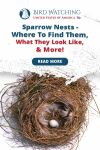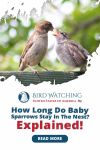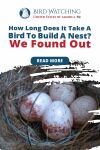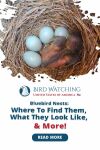
What’s This Post About?
Sparrows, often known as ‘little brown jobs’, are one of North America’s most common bird species. Sparrows, despite being abundant and widespread, are no less fascinating than the other birds.
They are difficult to spot most of the time; however, they can occasionally be observed wandering in the grass, swamps, or bushes.
When it’s challenging to spot the bird itself, smart bird watching entails researching about other things associated with the bird.
The easiest technique to spot a sparrow would be to spot where its nest lies.
To identify sparrows’ nests, you should be well versed about their appearance, and location amongst many other things.
Sparrows are human-friendly animals, and their nests, therefore, are found near populated areas. It gives them access to living spaces and an abundant food supply. Made up of mostly grass and straw, the nest has a tunnel-like entrance. There is usually a covering with a hole found above the nest.

When Does A Sparrow Build Its Nest?
The nesting process starts when the birds begin to look for potential mates. Before choosing the female mate, the male sparrow first finds a possible nesting site and hovers around it. Although nesting has been observed in all seasons, the primary nesting season seems to be from April to August.
When it comes to mating selection, the House Sparrow is believed to be monogamous. House Sparrows will begin the breeding cycle after they have chosen their spouse.
This can occur as early as March and last through the end of August. Pairs mate close to their nests.

Where To Find Sparrow Nests?
One of the most adaptive birds on the earth is the House Sparrow.
The bird’s adaptive nature is what makes it interesting, especially when it comes to nesting sites. The sparrows find nesting sites near humans. You will find them in various places, including common locations like tree cavities and uncommon ones like holes of buildings and structures such as street lamps.
They’ve travelled a great distance from their natural environment and have managed to become the most abundant bird found across the United States.
The House Sparrow’s choice – or lack thereof – when it comes to nesting is the primary justification for its flexibility.
To sum up, they aren’t very picky when it comes to choosing locations. They prefer densely populated areas but can also be found in less populated regions.
Though sparrows might take their time to build an entire nest from scratch in trees; however they are also open to using man-made birdhouses for nesting.

Some of the common site where you can locate sparrow nests include:
- Holes in trees
- Cavities in brick walls
- Birdhouses
- Ivy plants or other creepers on the wall
- Building holes
- Holes in other structures like street lamps, traffic light fixtures
- Gas station roofs
- Signboards
Did You Know?
House Sparrows are also fierce rivals for nest boxes, often displacing the bird for whom the box was initially placed.
Why Do Sparrows Prefer Urban Areas For Nesting?
We provide ideal habitat for house sparrows, much as other typical urban wild neighbors.

In North America, there are several distinct types of sparrows. House sparrows are frequently one of the only birds ready to dwell in densely populated areas. This is most likely due to their exceptional ability to capitalize on the possibilities humans provide to them as nesting sites.
The food and shelter we give are ideal for house sparrows. They like to reside in areas with a lot of people. House sparrow, as the name implies, will make itself at home in our houses.
Popular nesting spots include dryers and other openings and holes, such as near window-mounted air conditioning units.
As mentioned before, they are the most adaptable birds. This is not limited to nesting sites but also their feed. This is what makes human-populated areas so attractive to them.
House sparrows eat grains, seeds, insects, and our wasted food. You can even find them fleeing to collect the waste that houses and restaurants dispose of.
Vehicles often crush insects like moths, the remains of which are fed by these house sparrows.
I would call them opportunists, wouldn’t you?

What Do Sparrow Nests Look Like?
The nest may be made upon cloth, coarse grass, and even trash like cigarettes or plastic.
A House Sparrow nest’s appearance is determined by its location. Nests of House Sparrows situated in densely populated regions are less structured because the foundation is already provided. Nests of House Sparrows situated in trees and bushes are usually well-built with more effort and material.

The nest that is situated in any sort of building structure has less material. This is because the already built structure serves as the foundation.
They’re often constructed of straws and other waste material, including trash. Feathers are frequently used to coat these nests.
Did You Know?
Feathers for nests may even be plucked from a live pigeon.
However, a nest that has to be built from scratch needs a foundation. That foundation is usually made from twigs and other plant material. The nest often takes the shape of a dome.

What’s observed common between all nests is that they have a tunnel-like appearance. House sparrows either look for structures that provide a tunnel-like entrance or build one that gives the impression of an enclosed space.
Nesting materials are pushed into gaps in construction until they are almost filled.
How Long Do Sparrows Nest?
Sparrows stay within a distance of 1.25 miles of their nest during the nesting period.
Once the sparrows mate, the nest is used throughout the brooding period. Both parents feed the nestlings until considered independent. In about 10 days, young sparrows become self-sufficient. About two weeks after hatching, the young depart the nest.
The female lays two to five eggs per day and typically begins incubation halfway through the egg-laying process. The chicks hatch after 11-14 days, and both sexes incubate.
Nesting responsibilities are split evenly between the parents. Chicks are brooded for 6-8 days, but it is not until they are 10 or 11 days old that they can regulate their body temperature.

As the mother gets ready for the next brood, post-fledging care is usually entrusted to the father. Within days of the last brood leaving the nest, she might start laying new eggs.
Did You Know?
The baby sparrows also nest close to where they were born. They are present throughout the year and seldom leave their immediate region.
Sparrow Nesting Habits
House Sparrows are incredibly competitive. If you don't see any of your favorite species at your feeder, house sparrows have probably driven them away.
The male House Sparrow is in charge of guarding the nesting location. Although there is no known region that the House Sparrow considers to be its territory, it has been noted that the male House Sparrow aggressively guards the small region around its nest.
Did You Know?
Sparrows don’t fly further than 5 miles of their nest and consider it their territory.
They have been recorded evicting other birds from their nests only to use them. House Sparrows have been known to build new nests on top of old ones, even the ones filled with alive young birds! The house martin is particularly vulnerable to such attacks.

House Sparrows construct nests adjacent to each other on occasions, and these nests may share walls. House Sparrows reuse their nests frequently because of the comfort.
If, however, the nest isn’t stable enough to be reused, they wait for their nests to collapse every winter so that they may construct a new one in the exact location.
Sparrows Nesting In Your House!
They may be called house sparrows, but they aren’t exactly house friendly.
House sparrows are often termed pests because of the inconvenience they bring to the residents living around their chosen habitat.

What Problems Do Sparrow Nests Cause?
You may be curious why these seemingly precious birds are the reason for the annoyance for many.
The feed and nesting behaviors that make the bird look adaptive become increasingly uncomfortable for the people around it.
Read through some of the common problems that sparrow nests may cause.
-
The sound of nesting sparrows may get disturbing. The volume might be bothersome, mainly because they begin singing at the first sign of light.
-
House sparrows prefer to construct their nests in, on, or near our structures. However, their propensity of stuffing nesting material into stove, dryer, and fan vents might prohibit them from using them.
-
Driving away other birds and hoarding their feed and nests.
Solutions to Avoid Nuisance Caused by Sparrow Nests
The best solution for any problem is prevention. Removal of nests can get messy, and not everyone has the heart to demolish a bird’s house.
Since we already know the potential places a house sparrow can take shelter in, we can work that to our advantage.
A house sparrow sees empty spaces and cavities in walls or structures and assumes it as a potential nesting area. What you can do to prevent this is, close all visible open spaces around the house.

You can do the following things to make such places become a less desirable spot for the birds!
- Cover the vents
- Install screens over windows and grills
- Block cavities with clothing or netting
Even if it’s too late for prevention and the house sparrow has welcomed itself into your home, don’t worry; you can still help yourself.
To take action, in this case, it is imperative first to check if there are any sparrow eggs or babies around or not.
Let’s now talk about if the nest is in the walls.
Before removing the nest, you have to ensure that the babies are away. Wait for them to leave the nest and then take prompt action.
Quickly remove the nest and block the area with any material like cloth or net.
If you notice that the eggs have not hatched yet, wait it out!
You will have to wait for the babies to come out. The young hatch at various times and leave after a couple of days. However, you might have to wait 2 to 4 weeks.
Pro-Tip
Check the nest regularly. Remove nest debris and exclude the birds as soon as the young leaves to prevent them from building a second nest.
If the nest is built inside vents, the situation can get more complicated, but in most cases, the removal is similar to the ones in the walls.
Pro-Tip
When birds use vents, they create noise that the vent amplifies. If you hear scraping and shuffling, take action immediately.
Problems With The Removal Of The Nest

There are a variety of reasons why dismantling nests on your own is not a good idea.
For starters, cleaning their nests necessitates working with their feces, which can be dangerous and filthy, exposing you to many diseases carried by sparrows.
In the situation where the nest has been resided by the birds, it is recommended that you call for professional help.
In such instances, wildlife professionals can offer guidance and assist in the control of undesirable nuisance bird species.
## Keep Reading!
Being the most adaptive bird that exists, a house sparrow is extremely widespread. This is mainly around areas that are densely populated because of the food and shelter provision the birds get.
This can get highly inconvenient for the residents, but you can resort to preventive and removal methods.
They are not fussy about what they eat or where they build a nest. This is the reason why they may even end up intimidating other species.
They will build a nest wherever they find space, with the nesting material varying upon the location.
Now that you know a lot more about sparrow’s nests read this interesting post on everything about hummingbirds nests. It’s just as fascinating!
Everything About Hummingbird Nests - Impressive Facts to Know All in One Post
Have you been looking for everything on hummingbird nests? Well, we’ve got you covered. Here is a compilation of this bird’s nesting habits.

By David A. Swanson
Bird Watching USA
My name is David and I'm the the founder of Bird Watching USA! I started Bird Watching with My father-in-law many years ago, and I've become an addict to watching these beautiful creatures. I've learnt so much over about bird watching over the years that I want to share with the world everything I know about them!

David A. Swanson
Bird Watching USA
My name is David and I'm the the founder of Bird Watching USA! I started Bird Watching with My father-in-law many years ago, and I've become an addict to watching these beautiful creatures. I've learnt so much over about bird watching over the years that I want to share with the world everything I know about them!









